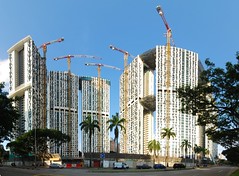ICICI Bank, India’s No. 2 lender, posted on Friday a larger-than-expected 31 percent rise in quarterly profit and forecast a higher growth rate for domestic loans and stable asset quality for the coming year.
Loan demand in India is expected to pick up after the central bank last week cut its benchmark lending rate for the first time in three years to help revive sagging economic growth. The Reserve Bank of India has projected loan growth for Indian banks for fiscal year 2013 at 17 percent against 16 percent in the previous year.
ICICI expects its domestic loans to grow 20 percent in the year that began in April from 17 percent last year, driven by demand from companies for working capital, home and car loans, Chief Executive Chanda Kochhar told reporters.
“These numbers may give us comfort to keep what we have (but) we don’t have any particular plans to increase our stakes. We have concerns about the India story in general,” said Olsson Jan-Olov, portfolio manager of Carnegie Emerging Markets at Sweden, which owns ICICI shares.
“We have been a little hesitant towards increasing positions in India due to the overriding political and macro economic situation.” Earlier this week, Standard & Poor’s cut India’s credit rating outlook to negative from stable on hefty fiscal and current account deficits and political paralysis in Asia’s third-largest economy.
The negative outlook jeopardises India’s long-term rating of BBB-, the lowest investment grade rating. Indian banks are actively easing terms on loans for companies, as high interest rates and an economic slowdown has hurt the ability of some to repay loans on time. Power, textile, aviation, construction and real estate are the hardest hit sectors.
ICICI, which is also listed in New York and competes with State Bank of India and HDFC Bank, sees a “very small” and “minimal” pipeline for corporate debt restructurings, Kochhar said.
